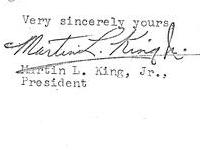This blog was written by Lynn Darby, a Cultural Fieldwork Intern from Temple University’s School of Education.
So what was the Civil Rights Movement?
A historic time in American History, the Civil Rights Movement was a monumental step towards equality as it challeneged the segragationist status quo of American life and opportunity. While there were many different approaches about how to combat this problem of racial bias, one ideological leader rose above the rest and cemented his teachings in history— Martin Luther King, Jr. If you are teaching about Martin Luther King, Jr., local Philadelphia history during the Civil Rights Movement, or just the movement itself, HSP has just what you need in a correspondence between King and local civil rights activist, Morris Milgram. The Draft of letter from Morris Milgram to Martin Luther King, Jr., August 20, 1963 and the Martin Luther King Jr. letter to Morris Milgram, April 17, 1957 provide an intimate look into the movement's organization and King's magnamity as its leader.
How to use it?
These sources are certainly unique and can be used in a multitude of different lessons with a wide range of topics that relate to them. Ideally, these would be perfect for students to examine when looking at the character of King and how he operated professionally. As a possible introductinary activity, have students read the two letters and list at least three inferences that can be made not only about the character of King, but the workload he had as a Civil Rights leader. After ten minutes reconvene as a class and record their responses on the board to evaluate to spark discussion about King.
How else?
There are certainly other ways to use these sources as they are extremely versatile. An additional lesson might involve students taking the two letters of correspondence home to read and evaluate for a larger research project around the history the correspondence documents. What was the Deerfield Freedom of Residence Battle? How did it impact the D.C. area? What was the relationship between King and Milgram? What work were they able to do together? What was King doing in Philadelphia which he addressed in his letter? These are all questions to ask students to work in groups or individually solve through additional resources.

